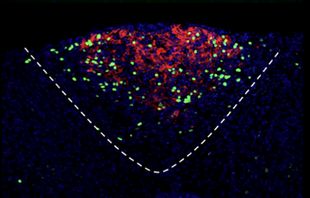Obesity and type 2 diabetes are increasing health problems worldwide. The newly developed GIPR:GLP-1R co-agonists address two hormone receptors in the human body at the same time: the glucose-dependent insulinotropic polypeptide receptor (GIPR) and the glucagon-like peptide-1 receptor (GLP-1R). These receptors play a crucial role in the regulation of glucose metabolism and insulin secretion.
PD Dr. Timo Müller and his research team have investigated the molecular mechanisms and the role of GIP in more detail. The study shows that GIP acts in the brainstem via specific inhibitory neurons, in particular via the so-called GABAergic neurons. The GIPR:GLP-1R co-agonist reduces body weight and food intake by signaling in these inhibitory neurons. If the GIP receptor is missing in these nerve cells, the weight-reducing effects of GIP disappear.
Timo Müller, senior author of the paper, emphasizes: "For the first time, these data illustrate that GIP regulates body weight and food intake in the brain by stimulating GABAergic neurons and emphasizes the necessity of the GIPR on these neurons for this ability to decrease body weight and food intake". First author Arek Liskiewicz adds: " Our data offer valuable insights into the mechanisms of GIPR:GLP-1R co-agonists, which can now be used to specifically target the brain GIP system for next generation anti-obesity drugs".

The picture shows in red the accumulation of GIP in the brain stem after a single peripheral injection and in green the resulting activation of neurons. Copyright: Nature Metabolism | ©Liskiewicz et al.
Original publication:
Liskiewicz et al. (2023): Glucose-dependent insulinotropic polypeptide (GIP) regulates body weight and food intake via GABAergic neurons in mice. Nature Metabolism. DOI: 10.1038/s42255-023-00931-7

